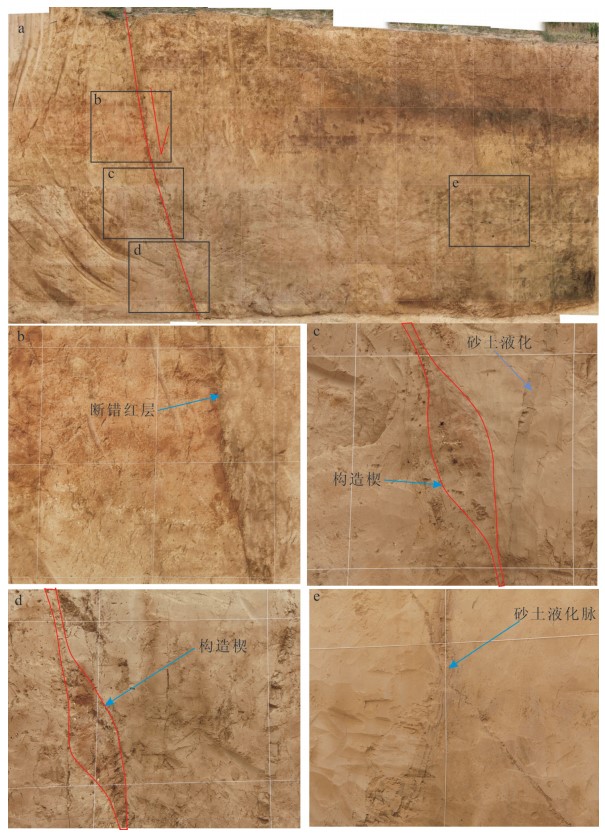The activity characteristics of the southern section of the Taigu fault in Shanxi since the Late Pleistocene
-
摘要:
太谷断裂为太原盆地的边界断裂,是晋中盆地研究程度较低的一条断裂。根据野外地质调查,断裂展布在黄土台地前缘,断错了盆地的洪积扇及河流阶地,是一条全新世活动的正断层。在上曹麻和北甲开挖了3个探槽,根据地层基本单元和年代学测试结果,探槽揭示了3次古地震事件,分别为8ka之后、11ka之后和17ka年之后。全新世垂直滑动速率为0.09mm/a;晚更新世以来的平均滑动速率为0.16~0.19mm/a。完善了太谷断裂的研究,为晋中盆地防震减灾提供可靠的科学依据。
Abstract:The Taigu fault is the boundary fault of the Taiyuan basin, and its research degree is relatively low among faults in Jinzhong (central Shanxi) basin. Field geological survey shows that the fault is spread in the forefront of the loess tableland and faulted the alluvial fan and fluvial terrace of the basin, being a Holocene active fault. Three trenches were excavated in Shangcaoma and Beijia. According to the stratigraphic basic units and dating results, the trenches reveal three paleoseismic events, which took place after 8ka, after 11ka and after 17ka respectively. The vertical sliding rate of Holocene is 0.09mm/a, whereas the average sliding rate since Late Pleistocene is 0.16~0.19mm/a. The results obtained by the authors have perfected the study of the Taigu fault and provide reliable scientific basis for the prevention and mitigation of earthquake disaster in Jinzhong basin.
-
Keywords:
- Taigu fault /
- Late Pleistocene /
- trench /
- paleoseismic
-
黄金是人类发现的第一种贵金属,是美好和富有的象征,一直受到人类的喜爱。胶东是中国最重要的黄金基地、世界闻名的黄金产区,也是全球金矿床勘查和研究的热点区域。胶东金矿的开采历史悠久,最早可上溯至唐代。新中国成立以来,国家对胶东金矿的勘查一直非常重视,部署了大量地质工作。胶东地区也不负众望,不断涌现新的找矿突破,由建国初期的仅20余吨金资源量,到现今金资源总量超过5000 t,成为世界第三大金成矿区。目前,中国的黄金产量连续十多年居世界第一,其中胶东的三山岛、焦家、玲珑和新城4座矿山建国以来累计生产黄金均超过100 t,胶东为中国的黄金产业乃至经济社会发展做出了重要贡献。
胶东屡现金矿找矿奇迹,产生了找矿勘查的多项第一。1965年,首次在胶东三山岛断裂的破碎蚀变带中发现了金矿体;1966年,在焦家断裂带中发现破碎带蚀变岩型金矿体并肯定了其工业价值。1969年完成的三山岛金矿区勘探,提交金资源量63.56 t,是中国探明的第一个特大型蚀变岩型金矿床;其后于1972年完成了焦家金矿床勘探,提交金资源量70余吨。1977年,全国第二次金矿地质工作会议以纪要形式,将焦家式破碎带蚀变岩型金矿(简称焦家式金矿)确定为中国新发现的金矿床类型。焦家式金矿的发现,突破了当时地学界“大断裂只导矿不贮矿”的传统认识,指导地质人员将找矿方向由以往的石英脉型金矿转向破碎带蚀变岩型金矿,陆续发现和探明了新城、河西、河东、新立、仓上、大尹格庄、台上等大型金矿床,奠定了胶东作为中国第一黄金基地的地位,推动了中国黄金产业的发展。1985年,《焦家式新类型金矿的发现及其突出的找矿效果》荣获国家科技进步特等奖(图片1),焦家式金矿成矿和找矿理论为中国的金矿勘查提供了重要指导。

进入21世纪,中国的地下浅表部金矿资源严重枯竭,地质人员在胶东地区开展了深部找矿探索。于2006年首先探明了莱州寺庄深部特大型金矿床,实现了“攻深找盲”的率先突破;2008年,完成了莱州焦家深部金矿详查,提交金资源量105 t,是胶东地区第一个一次性提交详查资源量超过百吨的金矿床;其后,胶东地区陆续探明了10余个资源量超过100 t的超大型金矿床,尤其是探明了三山岛北部海域、西岭、纱岭3个资源量均超过300 t的金矿床。2014年,在莱州湾东侧的浅海海域探明的三山岛北部海域金矿床,勘探资源量470余吨,是中国和世界上最大的海域金矿。随着深部找矿的持续推进,胶东地区的勘查和钻探深度不断刷新纪录。目前,已施工1500~3000 m深度的钻孔300余个,其中,三山岛、焦家、水旺庄、大尹格庄等矿区控制矿体的深度均已超过2000 m,是国内平均勘查深度最大的金矿区;已施工超过3000 m深度的钻孔3个,在莱州三山岛金矿深部(西岭矿区)施工的4006.17 m深孔被誉为中国岩金勘查第一深钻,在焦家断裂带深部施工的3266.06 m深度的钻孔是该成矿带见矿深度最深的钻孔。2011年全国找矿突破战略行动以来,胶东作为全国重要的整装勘查区之一,深部找矿取得了新的重大突破,10年新增深部金资源量约2958 t,新增资源量约占全国同期的40%,超过了胶东历史上累计探明金资源量的总和,三山岛、焦家和招平3条成矿带的金资源量均已超过千吨。深部找矿的过程也是找矿理论认识和找矿方法不断提升的过程,胶东型金矿热隆-伸展成矿理论、阶梯成矿模式、阶梯找矿方法、先进的地球物理勘探技术、深孔和海域钻探方法等在深部找矿中发挥了重要作用。通过三维可视化分析发现,三山岛和焦家地区的多个原来认为独立的金矿床在深部合为一体,实际上是2个资源量均超过千吨的超巨型金矿床。2014年,《胶东金矿理论技术创新与深部找矿突破》成果获得国家科技进步二等奖。2017年5月3日,原国土资源部专门举行胶东地区深部金矿找矿成果新闻发布会指出:“胶东地区金矿深部勘查重大突破具有世界级影响”。
全国找矿突破战略行动的实施,为胶东深部找矿突破提供了重要机遇。本专辑撷取了找矿突破战略行动以来有关人员在胶东深部找矿中开展的部分工作和取得的部分成果予以展示,主要包括以下4方面内容:矿床三维地质建模及基于三维模型对深部矿床空间分布和成矿规律的新认识,稳定同位素、矿石微量元素和矿物微区地球化学分析测试结果及对金成矿的指示,流体包裹体测试结果及成因解释,地球物理方法及其在胶东深部找矿中的作用。期望本专辑阐述的成果能为深化胶东金成矿的认识及指导进一步找矿提供启发和帮助,也期望中国其他地区的深部找矿和相关研究能从中得到有益借鉴。
胶东地区金矿找矿不断取得新突破,得益于国家有关部门的高度重视和大力支持,得益于地勘队伍、科研院所和矿山企业的共同努力,得益于广大工程技术人员、基础理论研究人员的艰苦努力和无私奉献。山东省地质矿产勘查开发局第六地质大队无疑是胶东金矿找矿的突出贡献者,该队探获了胶东50%以上金资源量,发现并建立了焦家式金矿矿床式,创新了金矿成矿理论,提出了金矿找矿新方法,也因其突出的找矿贡献获得了崇高的荣誉:1992年10月19日国务院下达了《国务院关于表彰山东省地质矿产局第六地质队的决定》(国发〔1992〕59号),授予六队“功勋卓著无私奉献的英雄地质队”荣誉称号(图片2),于1992年12月10日在北京举行了隆重的命名大会,并授予奖旗;2009年9月19日,时任国务院总理温家宝在原国土资源部转呈的山东地矿六队胶东找矿成果汇报材料上亲笔批示“请国土资源部转告六队职工:祝贺他们在金矿勘探中取得的重大发现,向大家致以亲切的问候。”

2022年是山东地矿六队被国务院授予“功勋卓著无私奉献的英雄地质队”荣誉称号30周年,谨以此专辑纪念这一光荣的时刻,并向为胶东地区金矿勘查和找矿突破战略行动取得重大成果做出贡献的所有人致以崇高的敬意!
致谢: 光释光(OSL)样品由中国地震局地壳应力研究所实验室的赵俊香进行样品测试,江娃利、张世民、马保起和李德文老师在野外工作上给予了帮助和指导,在此谨对上述同仁致以衷心的感谢。 -
-
邓起东, 王克鲁, 汪一鹏, 等.山西隆起区断陷地震带地震地质条件及地震发展趋势概述[J].地质科学, 1973, 1:37-47. 孟繁兴, 刘光勋, 肖振敏, 等.利用地质和考古方法研究山西平遥活动层的现代构造运动[C]//中国地震学会地震地质专业委员会编, 中国活动断裂.北京:地震出版社, 1982:127-132. 苏宗正.山西断陷带地震活动的新构造背景[J].山西地震, 1988, 4:2-6. http://www.cnki.com.cn/Article/CJFDTOTAL-SXDZ198804001.htm 徐锡伟, 刘国栋, 邢集善, 等.山西地堑系地表构造特征及深部背景[C]//国际大陆岩石圈构造演化与动力学讨论会、第三届全国构造会议论文集亚.北京:科学出版社, 1990:112-120. 王圣洁, 杨景春.晋中盆地新构造运动特征[C]//王乃梁, 杨景春, 夏正楷, 等.山西地堑系新生代沉积与构造地貌.北京:科学出版社, 1996:260-277. 江娃利, 肖振敏, 谢新生.鄂尔多斯块体周边正倾滑活动断裂历史强震地表破裂分段[J].地震学报, 2000, 22(5):517-526. http://www.cnki.com.cn/Article/CJFDTOTAL-DZXB200005008.htm 谢新生, 江娃利, 王焕贞, 等.山西太谷断裂带全新世活动及其与1303年洪洞8级地震的关系[J].地震学报, 2004, 26(3):281-293. http://www.cnki.com.cn/Article/CJFDTOTAL-DZXB200403006.htm 江娃利, 谢新生.正倾滑活动断裂垂直位移定量研究中相关问题的讨论[J].地震地质, 2002, 24(2):177-187. http://www.cnki.com.cn/Article/CJFDTOTAL-DZDZ200202004.htm 江娃利, 谢新生, 王瑞, 等.山西断陷系交城断裂全新世古地震活动初步研究[J].地震研究, 2004, 27(2):184-190. http://www.cnki.com.cn/Article/CJFDTOTAL-DZYJ200402011.htm 荆振杰, 刘风香, 谢富仁.太谷断裂砂土液化遗迹特征[C]//地壳构造与地壳应力文集, 2016, 27:10-190. 胡小猛, 傅健利, 马志正, 等.太原盆地洪山第四纪剖面的发现[J].地层学杂志, 2002, 26(3):226-229. http://www.cnki.com.cn/Article/CJFDTOTAL-DCXZ200203012.htm




 下载:
下载:










